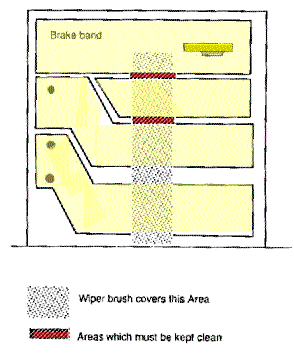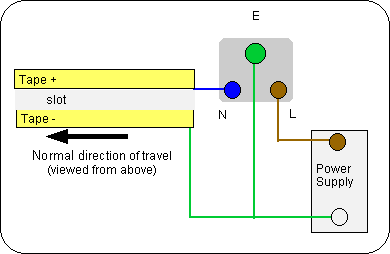Good Ways of Blowing up "Normal British" Transistorized Controllers (and How to Avoid them)
Updated January 2004
1) Shorting Out The Tapes
Another how it works question,,,, what happens if there's a short circuit across the motor (e.g. the chassis shorts out the tapes)?
Answer - The transistor tries to
provide more current to compensate. The PNP transistors commonly used areused in this controller circuit
MJI1015 Darlington rated at 30 amps and 200 watts
MJ14003 single transistor rated at 60 amps and 300 watts
(These are at 25 degrees C, and have to be reduced if the
transistor is hotter).
The MJ14003 (used in the Paul Bucknell design) is less likely to suffer damage
from shorts than the "normal British" MJI1015 because of the higher
ratings. However a short circuit could exceed both the current and heating
limits of these transistors.
What does this mean?
Answer - If you get a good solid short, the transistor WILL fail - you might get away with instantaneous shorts, but these could cause some damage to the transistor which will cause odd characteristics and perhaps failure next time the transistor gets a little warmer than normal.
How do you get round this problem?
Answer - well apart from redesigning the controller circuit (and if you know how to do that perhaps you won't need to read this article) put some sellotape on the bottom of you cars so they don't short out the tapes. Always unplug your controller (or at the very least don't press it) when somebody is putting the tapes down - if they are using something solid and metal it will produce a very good short circuit. If you are repairing the tapes please take a care to warn the driver! (Quite apart from any controller damage, it'll stop them driving their cars into you!)
2) Other Good Ways of Producing Short Circuits
Something which has always surprised me is that lots of transistors are bolted direct to the heatsink so the whole of the metalwork is connected to the collector terminal - the tape + on the track. This is all very well as long as it doesn't come into contact with (for example) the negative tape , the brake terminal on a controller plugged into the next lane or the fixing screw of a controller socket*. This sort of thing causes the transistor to fail (often to dead short which will put your car straight into the wall). This is not a problem that occurs very often, but it could be prevented with a transistor mounting/insulating kit at a cost of a few pennies.
There is a small disadvantage to insulating the transistor. Electrical insulation will also increase the thermal resistance between the transistor and heat sink. This means that the transistor will run slightly hotter in order to transfer the same amount of heat. If you use heat sink compound and bolt down the transistor properly (do the screws up tight) the temperature difference should be small. Higher temperature = less reliability, if you think this small temperature rise due to insulation will make any difference I would recommend you fit a slightly larger heat sink and insulate the transistor - or better still a much larger heat sink and insulate the transistor.
* Modern controller sockets have the fixing screws connected to the E terminal (the negative power supply on a slot track).
3) Some Like It Hot!! (but your transistor doesn't)
How hot does it get - well this type of transistorized controller produce just as much heat as a variable resistance controller (a diode controller also produces the same amount of heat). Transistors are easy to mount on heatsinks to get rid of heat ,,, and a good thing too because a controller resistor can run at much higher temperature without failure - also a controller resistor often starts to smell before it fails (so there is time to change before it blows or stinks out the clubroom) but a transistor will just fail. To avoid transistor failure you must stop it getting too hot - the only way to do that is to mount it on a big enough heat sink. As a rule of thumb (or finger?), if after a couple of minutes running the transistor is gently warm to the touch its OK - if it's hot to the touch (50 degrees or above) then a larger heat sink would help reliability and if its too hot to keep your finger on, (70 degrees C or above) then unplug it quick! - it either has a fault or it needs to get rid of more heat - try a larger heat sink or a fan. Transistor manufacturers typically recommend about 20% reduction in current if the case is running at 50 C and around 40% reduction at 75C . If you do need a bigger heat sink, probably the easiest way of getting something effective is to buy a larger heat sink from one of the electronics suppliers. These days a heat sinks intended for computer processors are widely available, and are very suitable. However heat sinks don't have to be a length of finned aluminum - anything that helps get rid of heat will do - the metal box bolted to the finned aluminum (as on the SCD controller) will increase it's effectiveness. Also some heat sink compound will help a little. Why can't I tell you what size heat sink you need? Well, the amount of heat a controller produces depends on many things, a big enough heat sink for all possible circumstances would be far too large for most people. Things which make controllers run hotter are;-
Inexperienced drivers,
Twisty Tracks with short
straights,
Lack of track knowledge,
Good power supplies and thick
track wiring,
Hot Motors ,
Poor car handling,
Controller faults
4) The Dirt Bits!
Probably the most frequent cause of transistor failure is tracking between the brake terminal and the top of the resistor contacts. This is caused by a conductive deposit on the contact board where the wiper runs - usually remains of the contact brush etc. Initially this causes the transistor to get warmer than normal (because it is partly switched on when the controller is on Brake), if not corrected this causes the transistor to get hotter until it fails. Many people have noticed the transistor getting warm and solved the problem by cleaning the tracking off the board before it causes a serious problem. The areas marked in red on the diagram are the important areas to clean.

You can
avoid this problem by cleaning the board every couple of months as a matter
of routine maintenance. Some controllers are very much more prone to this problem
than others. The deposit builds up much more quickly when copper/carbon brush
material is used as the wiper and it also depends on the gap between the brake
band and the top of the resistor. Incidentally, if you are wondering why this
was never a problem on variable resistance controllers (it shouldn't be a problem
on Diode controllers either), the answer is that the tracking probably does
occur, but the tiny currents that pass through the tracking are negligible to a
slot car motor - but they are multiplied 1000+ times by the transistor.
Incidentally,
just checking the resistance of suspect tracking with a normal meter can give
misleading results. Tracking may pass no current at the very low voltages
meters use to measure resistance but pass significant
current it the sort of voltages present in the operating controller. I recently
found one controller that was blowing transistors - measuring the resistance of the tracking with a
normal meter
showed more than adequate insulation (over 2 megohms)
but when I put 10 volts across it the tracking was passing lOmA which is plenty
of current to switch on a transistor and cause heating problems.
The diagram above shows( in red) the area that needs to be kept clean on an SCD
controller.
5) A Bridge Too Far
Another problems that can cause transistor failures - not to mention damage to variable resistance controllers - is the wiper bridging the gap between the brake and the resistor (even momentarily). Make sure the wiper cannot touch the resistor contact and the brake at the sale time - it is much safer if there is some "Dead" wiper travel (that is after the wiper leaves the brake there should be some travel when it's not connected to anything before it makes contact with the resistor).
Where controllers have separate brake contacts, power contacts, or full power relays make sure they work in the correct sequence. Generally this is how the should work (starting with the trigger / plunger in the fully released position)
| Step in the sequence | Notes |
| 1 The separate brake contact goes open circuit | Contact not present in some controllers |
| 2 The wiper leaves the brake contact | |
| 3 The wiper driving the transistor makes contact with the top of the resistor chain | |
| 4 The wiper makes contact with the full power part of the wiper board | |
| 5 The separate full power contact makes contact | Contact not present in some controllers |
| 6 Full power microswitch turns on | Full power microswitch not present in some controllers |
| 7 The full power relay cuts turns on | Relay not present in some controllers |
The controller must follow the sequence in reverse when releasing the trigger / plunger from the full power position Note microswitches and relays often don't release at the same point they make contact, so you need to check the sequence in both directions.
6) Track Wired Incorrectly
Transistors only pass current in one direction - if the track is wired to BSCRA standards (with the controller between the + side of the power supply and the track) the normal circuit works fine. If the track is wired incorrectly (with the controller between the negative side of the power supply and the track) your transistor will blow up. Incidentally, this has got nothing to do with wiring the car up to go forwards or backwards.
 Correct
Track Wiring (updated to 2003 BSCRA Standards)
Correct
Track Wiring (updated to 2003 BSCRA Standards)
If you do want a transistorized controller with the "normal British" circuit to work the other way round (and this is probably more work than correcting the track wiring) use the same circuit with different transistors (to put It technically, replace PNP with NPN transistors)- MJ11016 replaces MJ11015 ; TIP3O55 replaces TIP2955 ; TIP4I replaces TIP42. BUP52 replaces the MJ14003
However, the rest of the country's transistorized controller owners will still have their controllers wired for normal track wiring, so unless you are really dedicated to discouraging new members who have moved from other clubs and visitors, it really is a good idea to wire the track up the standard way round.
If you do ever blow up a transistor on one of these controllers, the part code is printed on the transistor so a direct replacement can be purchased from a slot racing supplier or transistor stockest. I used to be able to suggest alternative higher power rating transistors, but the range of high power PNP transistors available seem to be decreasing. Another nuisance is that retail stockists don't seem to keep the MJ11015 any more so replacement transistors are only available from professional electronics stockists. If you have difficulties getting a TIP 42, it can be replaced by a TIP2955.